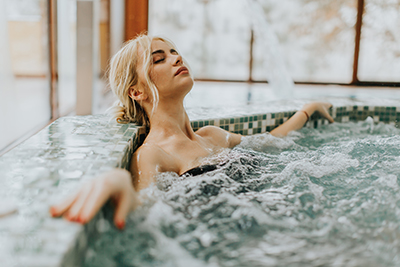 Hydrotherapy is the use of water, both internally and externally and at varying temperatures, for health purposes. Also known as water therapy, hydrotherapy includes such treatments as saunas, steam baths, foot baths, contrast therapy, and hot and cold showers.
Hydrotherapy is the use of water, both internally and externally and at varying temperatures, for health purposes. Also known as water therapy, hydrotherapy includes such treatments as saunas, steam baths, foot baths, contrast therapy, and hot and cold showers.
Hydrotherapy is a part of alternative medicine that involves the use of water for pain relief and treatment. It can be helpful in the treatment of anxiety because it induces relaxation while stimulating neurotransmitters in the brain.
The term hydrotherapy encompasses a broad range of therapeutic methods. Various therapies used in the present-day hydrotherapy employ water jets, underwater massage, mineral baths, whirlpool baths, hot Roman baths, hot tubs, Jacuzzis, cold plunges, and mineral baths.
Hydrotherapy is an important, time-tested adjunct to bodywork modalities. Use of water to heat, stimulate and relax the body has been used for thousands of years by many cultures throughout the world.
The therapeutic use of water was recorded in ancient Egyptian, Greek and Roman civilizations. Egyptian royalty bathed with essential oils and flowers, while Romans had communal public baths for their citizens.
Hippocrates prescribed bathing in spring water for sickness. Other cultures noted for a long history of hydrotherapy include China and Japan. As hydrotherapy goes, it can be a simple at-home remedy that can provide substantial benefit with minimal effort. In this respect, hydrotherapy can be the simple application, such as a hot bath with essential oils.
Balneotherapy is a type of hydrotherapy. It involves using water or bathing to treat illness, such as a warm bath in the evening, or baths taken in water with altered mineral content. Research suggests patients with anxiety can benefit from the mechanisms of balneotherapy. In a French study, balneotherapy was compared to the antidepressant paroxetine (Paxil). The study was for eight weeks, with 237 patients with generalized anxiety disorder who were assigned randomly to either balneotherapy or medication. The balneotherapy treatment consisted of daily bath treatments using natural mineral waters (sodium, calcium, magnesium and sulfates) for 21 days.
Every morning, patients were immersed in a bubbling bath (98.6°F for 10 minutes) followed by a shower and a 30 minute massage. The anxiety scores showed an improvement in both groups, but there were better results with the water therapy compared to the effect of the drug. Moreover, the medication group experienced drug side effects whereas the balneotherapy group did not.
Medical research has supported the use of hot and cold baths. Decreases in stress hormones (like cortisol) have been reported with water bathing. It has also been shown that water bathing may also help the balance of the neurotransmitter serotonin. Footbaths have been shown to induce relaxation by decreasing that stress response.
Applying water of different temperatures to the skin can change physiology and mood. For example, taking a cold shower is typically very invigorating. This is because the combination of wet and cold causes the blood vessels near the surface of the skin to vasoconstrict; making blood move from the surface of your body to the core as a means to conserve heat. In the process of conserving heat, the brain and vital organs are reflexively bathed in fresh blood. This action results in an improvement in mood and a reduction in anxiety.
Dr. Randi Fredricks, Ph.D.
Author Bio
Dr. Randi Fredricks is a leading expert in the field of mental health counseling and psychotherapy, with over three decades of experience in both research and practice. She holds a PhD from The Institute of Transpersonal Psychology and has published ground-breaking research on communication, mental health, and complementary and alternative medicine. Dr. Fredricks is a best-selling author of books on the treatment of mental health conditions with complementary and alternative medicine. Her work has been featured in leading academic journals and is recognized worldwide. She currently is actively involved in developing innovative solutions for treating mental health. To learn more about Dr. Fredricks’ work, visit her website: https://drrandifredricks.com
References
Abbott, George Knapp (2007). Elements of Hydrotherapy for Nurses. Brushton, NY: Teach Services.
Cayleff, Susan E (1991). Wash and Be Healed: The Water-Cure Movement and Women’s Health. Philadelphia, PA: Temple University Press.
Dubois O, Salamon R, Germain C, Poirier MF, Vaugeois C, Banwarth B, Mouaffak F, Galinowski A, Olié JP. (2010). Balneotherapy versus paroxetine in the treatment of generalized anxiety disorder. Complement Ther Med, 18(1), 1-7.
Marazziti D, Baroni SG et al. (2007). Thermal balneotherapy induces changes of the platelet serotonin transporter in healthy subjects. Progress in Neuro-Psychopharmacology & Biological Psychiatry, 1(3), 1436–1439.
Toda M, Morimoto K, Nagasawa S, Kitamura K. (2006). Change in salivary physiological stress markers by spa bathing. Biomedical Research, 27, 11–14.
Yamamoto K, Aso Y et al. (2008). Autonomic, neuro-immunological and psychological responses to wrapped warm footbaths—a pilot study. Complementary Therapies in Clinical Practice, 14, 195–203.

